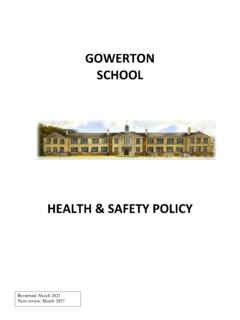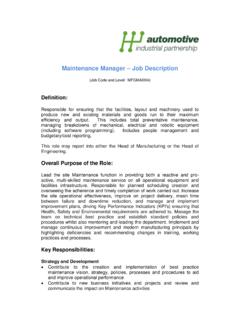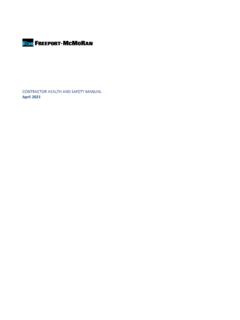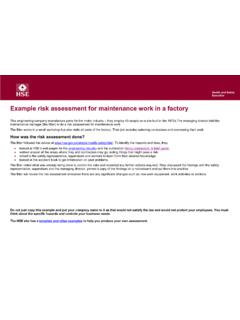Transcription of Avoiding danger from overhead power lines GS6 - HSE
1 Page 1 of 12 health and Safety ExecutiveAvoiding danger from overhead power linesGuidance Note GS6 (Fourth edition)This general series guidance note is for people who may be planning to work near overhead lines where there is a risk of contact with the wires, and describes the steps you should take to prevent contact with them. The fourth edition makes the advice easier to follow and has brought the supporting visuals up to date. The guidance has not fundamentally changed from the previous is primarily aimed at employers and employees who are supervising or in control of work near live overhead lines , but it will also be useful for those who are carrying out the 2 Types of overhead power lines and their heights 2 What does the law require?
2 4 Preventing overhead line contact accidents 4 Working near overhead lines connected to buildings 8 Emergency procedures 8 Industry-specific guidance 9 Annex 1 The law 9 References 11 Further information 12 HSE BooksHealth and Safety Avoiding danger from overhead power lines Page 2 of 12 Introduction 1 Every year people at work are killed or seriously injured when they come into contact with live overhead electricity power lines . These incidents often involve: machinery , eg cranes, lorry-loader cranes, combine harvesters, and tipping trailers; equipment, eg scaffold tubes and ladders; work activities, eg loading, unloading, lifting, spraying, and stacking. 2 If a machine, scaffold tube, ladder, or even a jet of water touches or gets too close to an overhead wire, then electricity will be conducted to earth.
3 This can cause a fire or explosion and electric shock and burn injuries to anyone touching the machine or equipment. An overhead wire does not need to be touched to cause serious injury or death as electricity can jump, or arc, across small gaps. 3 One of the biggest problems is that people simply do not notice overhead lines when they are tired, rushing or cutting corners. They can be difficult to spot, eg in foggy or dull conditions, when they blend into the surroundings at the edge of woodland, or when they are running parallel to, or under, other lines . 4 Always assume that a power line is live unless and until the owner of the line has confirmed that it is dead. 5 This guidance is for people who may be planning to work near overhead lines where there is a risk of contact with the wires, and describes the steps you should take to prevent contact with them.
4 It is primarily aimed at employers and employees who are supervising or in control of work near live overhead lines , but it will also be useful for those who are carrying out the work. Types of overhead power lines and their heights 6 Most overhead lines have wires supported on metal towers/pylons or wooden poles they are often called transmission lines or distribution lines . Some examples are shown in Figures 1 1 275 kV transmission lineHealth and Safety Avoiding danger from overhead power lines Page 3 of 12 Figure 2 11 kV distribution lineFigure 3 400 V distribution line7 Most high-voltage overhead lines , ie greater than 1000 V (1000 V = 1 kV) have wires that are bare and uninsulated but some have wires with a light plastic covering or coating.
5 All high-voltage lines should be treated as though they are uninsulated. While many low-voltage overhead lines (ie less than 1 kV) have bare uninsulated wires, some have wires covered with insulating material. However, this insulation can sometimes be in poor condition or, with some older lines , it may not act as effective insulation; in these cases you should treat the line in the same way as an uninsulated line . If in any doubt, you should take a precautionary approach and consult the owner of the There is a legal minimum height for overhead lines which varies according to the voltage carried. Generally, the higher the voltage, the higher the wires will need to be above ground (see Figure 4).
6 Equipment such as transformers and fuses attached to wooden poles and other types of supports will often be below these heights. There are also recommended minimum clearances published by the Energy Networks Association (ENA Technical Specification 43 8 overhead line Clearances)1 between the wires and structures such as buildings and lamp and Safety Avoiding danger from overhead power lines Page 4 of 12275 400 kV132 kV33 kV11 kVLow voltageMinimum heightMinimum height Minimum height 7 m for 275 kV, m for 400 m m ( m above roads)Figure 4 Minimum heights above ground level for overhead power linesWhat does the law require? 9 The law requires that work may be carried out in close proximity to live overhead lines only when there is no alternative and only when the risks are acceptable and can be properly controlled.
7 You should use this guidance to prepare a risk assessment that is specific to the site. Guidance on how to carry out a risk assessment is available at 10 Businesses and employees who work near to an overhead line must manage the risks. overhead line owners have a duty to minimise the risks from their lines and, when consulted, advise others on how to control the risks. The line owner will usually be an electricity company, known as a transmission or distribution network operator, but could also be another type of organisation, eg Network Rail, or a local owner, eg the operator of a caravan park. More details about legal responsibilities can be found in Annex overhead line contact accidents 11 Good management, planning and consultation with interested parties before and during any work close to overhead lines will reduce the risk of accidents.
8 This applies whatever type of work is being planned or undertaken, even if the work is temporary or of short duration. You should manage the risks if you intend to work within a distance of 10 m, measured at ground level horizontally from below the nearest wire. Remove the risk 12 The most effective way to prevent contact with overhead lines is by not carrying out work where there is a risk of contact with, or close approach to, the wires. health and Safety Avoiding danger from overhead power lines Page 5 of 1213 If you cannot avoid working near an overhead line and there is a risk of contact or close approach to the wires, you should consult its owner to find out if the line can be permanently diverted away from the work area or replaced with underground cables.
9 This will often be inappropriate for infrequent, short-duration or transitory work. 14 If this cannot be done and there remains a risk of contact or close approach to the wires, find out if the overhead line can be temporarily switched off while the work is being done. The owner of the line will need time to consider and act upon these types of requests and may levy a charge for any work done. Risk control 15 If the overhead line cannot be diverted or switched off, and there is no alternative to carrying out the work near it, you will need to think about how the work can be done safely. If it cannot be done safely, it should not be done at all. Your site-specific risk assessment will inform the decision.
10 Things to consider as part of your risk assessment include: the voltage and height above ground of the wires. Their height should be measured by a suitably trained person using non-contact measuring devices; the nature of the work and whether it will be carried out close to or underneath the overhead line , including whether access is needed underneath the wires; the size and reach of any machinery or equipment to be used near the overhead line ; the safe clearance distance needed between the wires and the machinery or equipment and any structures being erected. If in any doubt, the overhead line s owner will be able to advise you on safe clearance distances; the site conditions, eg undulating terrain may affect stability of plant etc; the competence, supervision and training of people working at the site.


















